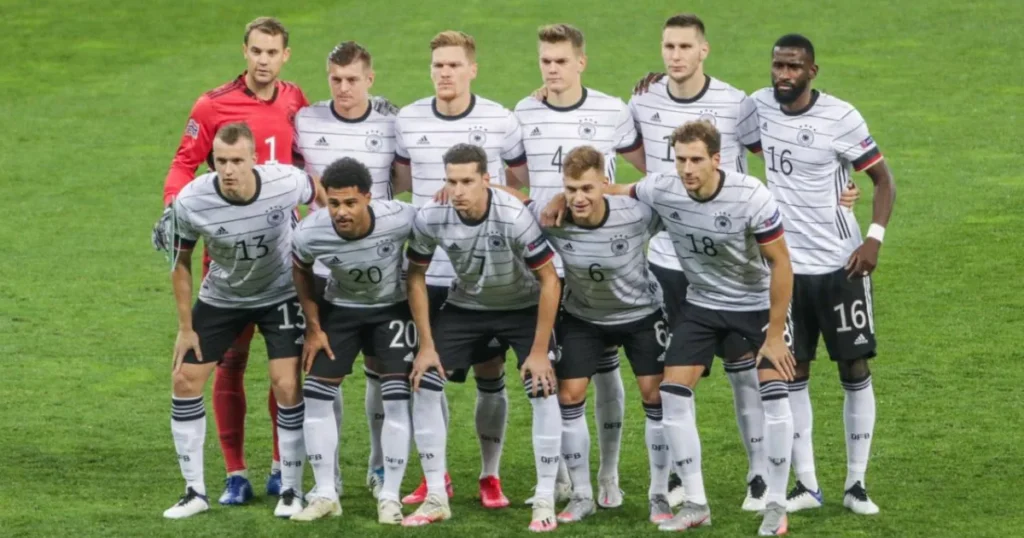When you think of football dynasties, few names evoke as much awe and respect as the Germany national football team. Known simply as Die Mannschaft—the team—this powerhouse has woven itself into the fabric of global sports history. From the miracle of Bern in 1954 to the clinical dominance of 2014, the Germany football team has been a symbol of resilience, tactical brilliance, and unbridled national pride. As we stand on the cusp of another World Cup cycle in 2026, let’s dive deep into what makes this squad tick. Whether you’re a die-hard fan or a newcomer curious about their storied past, this exploration covers the highs, the lows, and everything in between. Buckle up—it’s time to celebrate the black, red, and gold.
A Storied History: From Humble Beginnings to Global Dominance
The roots of the Germany football team stretch back over a century, a timeline marked by triumphs, divisions, and reunifications that mirror the nation’s own turbulent journey. Founded in 1900, the German Football Association (DFB) organized the first official international match in 1908 against Switzerland—a 5-3 loss that stung but sparked a fire. Early years were modest; Germany entered the Olympics in 1912 and the first World Cup in 1934, finishing third in the latter amid the shadow of political upheaval.
Post-World War II, the story truly ignited. West Germany, under coach Sepp Herberger, stunned the world at the 1954 FIFA World Cup in Switzerland. Trailing Hungary 2-0 in the “Miracle of Bern” final, Helmut Rahn’s 84th-minute equalizer and extra-time winner sealed a 3-2 victory, etching “Das Wunder von Bern” into legend. This triumph wasn’t just about football; it was a nation’s rebirth, lifting spirits in a divided Germany.
The 1970s brought more glory. As hosts in 1974, West Germany defended their European Championship title from 1972 and claimed the World Cup, defeating the Netherlands 2-1 in the final. Franz Beckenbauer, the elegant sweeper, captained the side and later managed them to victory in 1990—becoming the first person to win as both player and coach. That Roma triumph, a 1-0 win over Argentina via Andreas Brehme’s penalty, symbolized unity just months after the Berlin Wall fell.
Reunification in 1990 merged East and West, absorbing East Germany’s Olympic golds (1976) and bronzes into the fold. The 1996 European Championship win on home soil, decided by a golden goal from Oliver Bierhoff against the Czech Republic, reignited the fire. Fast-forward to 2014: Joachim Löw’s golden generation dismantled Brazil 7-1 in the semi-final before edging Argentina 1-0 in the final, thanks to Mario Götze’s extra-time magic. With four World Cups (1954, 1974, 1990, 2014), three Euros (1972, 1980, 1996), and a 2017 Confederations Cup, the Germany football team stands as one of only two nations (alongside Spain) to conquer both men’s and women’s World Cups.
Yet, history isn’t without scars. Group-stage exits in 2018 and 2022 tested resolve, but under Julian Nagelsmann, a new chapter beckons. The Germany national football team isn’t just a squad—it’s a chronicle of perseverance.
Major Achievements: Trophies That Echo Through Generations
What sets the Germany football team apart is sheer consistency. They’ve reached 13 major tournament finals, a record unmatched in depth and breadth. Four World Cup titles tie them with Italy, trailing only Brazil’s five. Their path includes four runner-up finishes (1966, 1982, 1986, 2002) and four bronzes (1958, 1970, 2008, 2010)—podium places in eight of 20 appearances.
In Europe, three Euros crowns highlight their continental mastery, with three silvers (1976, 1992, 2008) to boot. The 2017 Confederations Cup, a 1-0 extra-time win over Chile, showcased depth. Elo ratings peaked at 2,223 post-2014, second only to Brazil’s historical highs.
These aren’t just stats; they’re cultural touchstones. The 1954 win inspired a generation; 2014’s “Summer Fairy Tale” redux at home Euro 2024 (quarter-final exit to Spain) reminded fans why Die Mannschaft endures. As of November 2025, their legacy fuels ambition for a fifth World Cup star.
Key Players: The Architects of Modern Mastery
The Germany national football team boasts a blend of grizzled veterans and dazzling prodigies, a squad value exceeding €816 million. At the helm is Julian Nagelsmann, the 38-year-old tactician whose contract runs to Euro 2028. His blend of innovation and empathy has revitalized the side.
In goal, Marc-André ter Stegen (Barcelona, 34) challenges Alexander Nübel (Stuttgart, 28) for the No. 1 spot, with Oliver Baumann (Hoffenheim, 35) as backup. Defensively, Antonio Rüdiger (Real Madrid, 32) anchors alongside Nico Schlotterbeck (Dortmund, 25) and Jonathan Tah (Leverkusen, 29). Wing-backs Joshua Kimmich (Bayern, 30) and Maximilian Mittelstädt (Stuttgart, 28) provide thrust.
Midfield pulses with creativity. Jamal Musiala (Bayern, 22) and Florian Wirtz (Liverpool, 22)—the “Wusiala” duo—have combined for 11 goals in 2025, their dribbling and vision Nagelsmann’s secret weapons. Pascal Groß (Brighton, 33) and Aleksandar Pavlović (Bayern, 21) offer balance, while Leroy Sané (Bayern, 29) returns from injury to ignite the right flank.
Up top, Kai Havertz (Arsenal, 26) leads with six international goals this year, supported by Deniz Undav (Stuttgart, 29) and Nick Woltemade (Stuttgart, 24). Emerging stars like Angelo Stiller (Stuttgart, 24) and Robin Gosens (Union Berlin, 31) add depth. This mix—youth (average age 26.9) and experience—positions Germany for 2026 glory.
For a quick snapshot of the core squad, here’s a table highlighting key contributors based on recent call-ups and form:
| Position | Player | Club | Age | Caps | Goals | Key Strength |
|---|---|---|---|---|---|---|
| GK | Marc-André ter Stegen | Barcelona | 34 | 45 | 0 | Shot-stopping precision |
| DF | Antonio Rüdiger | Real Madrid | 32 | 78 | 1 | Aerial dominance |
| DF | Nico Schlotterbeck | Borussia Dortmund | 25 | 18 | 0 | Ball-playing composure |
| MF | Joshua Kimmich | Bayern Munich | 30 | 95 | 4 | Versatile leadership |
| MF | Jamal Musiala | Bayern Munich | 22 | 32 | 5 | Dribbling wizardry |
| MF | Florian Wirtz | Liverpool | 22 | 28 | 6 | Creative flair |
| FW | Kai Havertz | Arsenal | 26 | 41 | 12 | Clinical finishing |
| FW | Leroy Sané | Bayern Munich | 29 | 72 | 13 | Explosive pace |
This lineup, drawn from the November 2025 squad, underscores Germany’s blend of Bundesliga firepower and Premier League polish—perfect for understanding the team’s tactical edge.
Tactics Under Nagelsmann: Fluidity, Pressing, and Relentless Intensity
Julian Nagelsmann’s arrival in 2023 injected fresh energy into the Germany football team. Dubbed a “tactics nerd,” he favors versatility: 4-2-3-1 for possession dominance, 3-4-2-1 for counter-attacks, even 5-4-1 against elites. His hallmark? High-intensity gegenpressing—regain the ball within seconds, à la Klopp’s Liverpool.
Build-up starts low in a 4-2-3-1, with pivots like Pavlović shielding a back four. Full-backs (Kimmich, Mittelstädt) overlap, creating overloads. Midfield rotates: Musiala and Wirtz as “dribbling No. 10s” weave through lines, while Havertz drops deep for link-up play. Pressing triggers are immediate—lose the ball, swarm like wolves.
Defensively, it’s compact: Rüdiger sweeps, Tah marks tightly. Offensively, short passes in the final third risk turnovers but yield 13 goals in six recent wins. Nagelsmann’s emotional edge—fostering chemistry in short camps—has yielded a 50% win rate, blending club familiarity with national fire. It’s modern, exciting football, primed for 2026.
Recent Results: A Rollercoaster Building Momentum
2025 has been a mixed bag for the Germany national football team, blending dominance over minnows with stumbles against giants. Kicking off World Cup qualifying in March, they thrashed Luxembourg 4-0 (goals from Wirtz x2, Havertz, Undav), but a shock 1-1 draw with Slovakia exposed vulnerabilities—Musiala’s opener canceled by a late equalizer.
Euro 2025 prep saw friendlies: a 2-0 win over Denmark (Sané, Havertz) and a 3-1 triumph against the USA. Nations League highs included a 5-2 rout of Italy in March, but semis brought pain—a 2-1 loss to Portugal (Ronaldo brace) and 1-0 defeat to France in the third-place playoff.
October qualifiers rebounded: 2-0 over Northern Ireland (Woltemade, Musiala) and 3-1 vs. Slovakia, securing six points from nine. With a 10-4-1 record in 2025, the Germany FIFA ranking climbed to 10th by November—up two spots, reclaiming top-10 status after edging Croatia. Wins aggregate 13-3 in key stretches, signaling resurgence. Yet, that Euro 2024 quarter-final loss to Spain lingers—a 2-1 extra-time heartbreaker. Momentum builds, but consistency is key.
Upcoming Fixtures: Eyes on Qualification and Beyond
November 2025 is pivotal for the Germany football team. Their next match? A home clash against Luxembourg on November 14 at 7:45 PM UTC—vital for breathing room in Group A. Followed by Slovakia away on November 17, it’s do-or-die: level on points, a win secures top spot and direct 2026 qualification; a slip could force playoffs in March 2026.
Post-qualifiers, friendlies loom: Ivory Coast and Finland in late 2025, honing edges for the expanded 48-team World Cup (June-July 2026 in USA, Canada, Mexico). Group draw on December 5 could pit them against powerhouses. Nations League Final Four (June 2026) offers silverware, but focus is clear: fifth star. With a favorable group (Slovakia 52nd, Northern Ireland 71st, Luxembourg 92nd), Die Mannschaft eyes early qualification to build depth.
Fan Culture: The Soul of Die Mannschaft
No discussion of the Germany national football team is complete without its fans—the beating heart of Die Mannschaft. German football culture thrives on community, thanks to the 50+1 rule ensuring fan-majority ownership and affordable tickets (often under €30). Stadiums like Dortmund’s Signal Iduna Park erupt in the “Yellow Wall”—25,000 standing ultras creating a cauldron of noise.
Public viewings during tournaments draw millions: Berlin’s Fan Mile at Brandenburg Gate hosted a million for Euro 2024. Chants like “Süddeutschland, Ostland, Westland—alles im Verein!” unite East and West, a post-reunification balm. Beer flows (matchday ritual: Currywurst and a pint), but it’s inclusive—women, families, immigrants pack grounds.
Yet, challenges persist: racism mars social media, countered by anti-fascist groups like St. Pauli’s. The 2022 Qatar protest (One Love armbands) highlighted progressive stands. For nationals, football is safe nationalism—flags wave freely, a rarity in history-conscious Germany. It’s passionate, colorful, and communal: post-win car horns blare in euphoric traffic jams. Fans aren’t spectators; they’re co-authors of the legacy.
Future Outlook: Primed for World Cup Glory in 2026
As 2026 dawns, optimism swirls around the Germany football team. Nagelsmann’s project peaks here: a young core (Musiala, Wirtz) matures alongside Kimmich’s leadership, replacing retirees like Neuer and Müller. Ranked 10th in the Germany FIFA ranking (November 2025), they’re top seeds, with Elo hints at top-three potential.
Qualification looks assured—win November, and December’s draw favors them in the 48-team format. Tactics evolve: more rotations, pressing tweaks for endurance. Depth shines: Gruda, Stiller as wildcards. Löw calls Wirtz and Musiala “world-class already”—their flair could echo 2014’s joy.
Challenges? Injury woes (Sané’s return helps) and top-team tests. But post-Euro 2024 buzz lingers; a home-like atmosphere awaits in North America. Can they claim a fifth World Cup? History says yes—resilience defines Die Mannschaft. With Nagelsmann’s vision and fan fervor, 2026 could crown a new golden era.
The Germany national football team isn’t just playing for trophies; it’s inspiring a nation. From Bern’s miracle to potential 2026 magic, their journey captivates. What’s your bold prediction for the Germany next match? Share in the comments—Fieber is building!






